BLIGHT
2020 Season. Here is a photo from Daniel Daniels a menber of the gardeners world facebook page, who has kindly given me permission to use. It shows a bad attack of late blight, which has gone too far to control. I have recommended that he detroys the crop and burn it to be on the safe side, unefected tomatoes can be saved. If tyou catch it early enough you can spay the plants with a Bordeaux mix, this will not kill it but slow down the rate of spreading. However, it is best to cut out any effected leaves first. Leisons on the stem can be painted with a thicher Bordeaux mix.
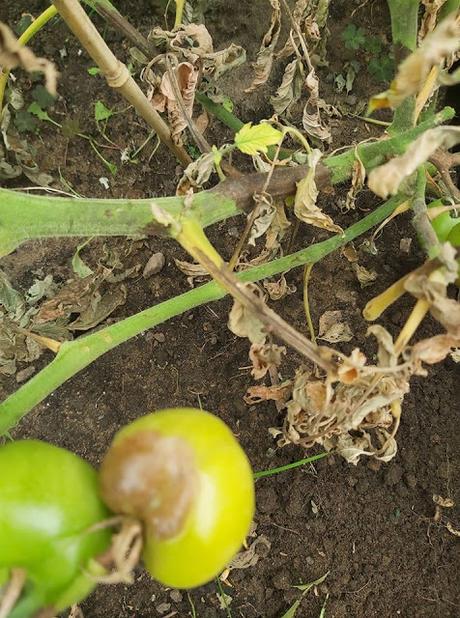
Late Blight
There is not a lot you can do if blight is in your area and it is not your fault if you get it. But there are ways to protect your crop and to treat it once you have it and minimise the damage.
So here are a few tips which might help;
1. Blight is airborne so have a lid on any containers that you use for water collection.
2. Bush tomatoes tend to have less air circulation around them, so try to keep them off of damp soil, and thin out as much as possible when there is blight about.
3. Water gently with a hose not a spray or irrigation so as not to wet the lower leaves.
4. With cordon plants, keep them well spaced (18" min) and de-leaf as much as possible.
5. Do not use too much nitrogen feed as this causes a softer plant.
6. Use a preventative spray as soon as you have a blight warning or when the weather turns damp.
7. Cut out and burn all affected leaves, or whole plants if it severe. Wash all equipment used.
8. Daily, do a tour of your plants to look for any signs of any new infections.
9. Blight tends to start on potatoes, grow them well away from tomato plants.
10. For Mr TK 'Take note of your own advice!'
Well it had to happen the dreaded blight has attacked my outdoor tomatoes. We have had fairly damp conditions of late and I should have put on a preventative spray of Bordeaux mix.
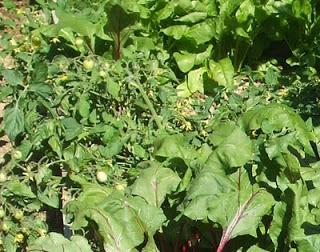 It started on these small bush plants, most of the leaves were touching damp soil and there is not a lot of air circulation. I have burnt the plants, tomatoes and all, as it was quite bad even though I had not noticed it 3 or 4 days before.
It started on these small bush plants, most of the leaves were touching damp soil and there is not a lot of air circulation. I have burnt the plants, tomatoes and all, as it was quite bad even though I had not noticed it 3 or 4 days before.By the time I had found it, some cordon plants close to it also had some small signs of late blight, so I saved the fruit of these, then burnt the plants as well. My polytunnel plants seem to be free of blight so far, but I have given these a good spray of Bordeaux mixture.
This plant looked OK until I inspected it further
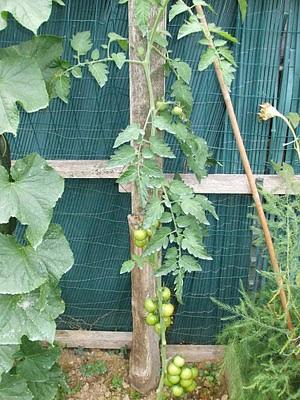
Below you can see the tiny first signs

The slight blackening of the leaf tip

On the stem
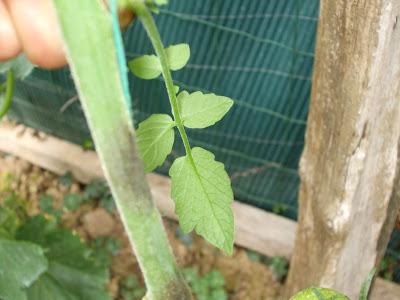
A tiny yellow mark in the center of the leaf.The blue on the leaf is the Bordeaux mix that I had sprayed before noticing the marks.

It is important when spraying to spray right inside the plant so as to get to the underside of the leaves and the stem.
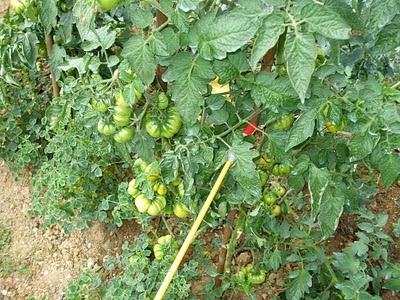
My indoor plants were stripped of leaves as much as I could before spraying. My plants are well spaced and this will aid air circulation, which will also help prevent disease.

I will add to this post so you can see how I get on. Hopefully, I can control the blight as I did notice it early enough. Some people do not like using Bordeaux mix as it can leave a residue of copper in the soil. I add some washing up liquid to my mix so that most of it will stick to the plant and I do not get too much run off.
More about blight and treatments.
Treatments
Bordeaux mix
Use as recommended, but can cause copper build up in the soil if there is too much run off.
Mancozeb Fungicide (Dithane) Used a lot in the UK.
Organic treatments for late blight
Regular compost tea
Early in the morning, place some of your finest quality compost in a porous cloth container and put it in a container full of cool water; an old sock for a gallon of water; a pillowcase or sack in a clean can full of water. If its town water, let it sit for a day first and stir it a few times to dissipate the chlorine. Let your tea steep for 24 hours, then strain the liquid and spray immediately the next morning; you want to use it right away to get the maximum number of little compost guys fighting for you. (Return the contents of your ‘tea bag’ to your compost pile.)
Baking Soda Spray I have never tried this, but sounds interesting it as a pray to kill spores.
For anthracnose, early tomato blight, leaf blight and spots, powdery mildew, and as a general fungicide
Sodium bicarbonate commonly known as baking soda has been found to possess fungicidal properties. It is recommended for plants that already have powdery mildew to hose down all the infected leaves prior to treatment. This helps to dislodge as many of the spores as possible to help you get better results. Use as a prevention or as treatment at first signs of any of the diseases.
To make: Mix 1 tablespoon baking soda, 2 1/2 tablespoons vegetable oil with one gallon of water. Shake this up very thoroughly. To this mix add 1/2 teaspoon of pure washing up liquid and spray. Be sure to agitate your sprayer while you work to keep the ingredients from separating. Cover upper and lower leaf surfaces and spray some on the soil. Repeat every 5-7 days as needed.
More pictures of late blight
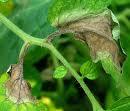
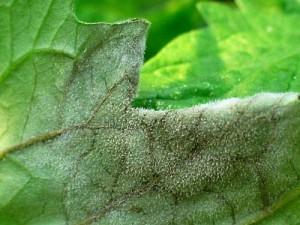 Late blight is one tomato disease that really upsets tomato growers as both the plant and fruit suffers. Once a plant has tomato blight there is very little that can be done about it and the plants have to be destroyed. Sometimes if it is caught in the very early stages it can be sprayed and stopped or if just a few leaves are affected they can be taken off and destroyed. Usually though, once it appears it will continue to be a problem to contend with during that growing season.
Late blight is one tomato disease that really upsets tomato growers as both the plant and fruit suffers. Once a plant has tomato blight there is very little that can be done about it and the plants have to be destroyed. Sometimes if it is caught in the very early stages it can be sprayed and stopped or if just a few leaves are affected they can be taken off and destroyed. Usually though, once it appears it will continue to be a problem to contend with during that growing season.So what is blight exactly? Blight is a fungal disease which grows on the tomato plant and destroys it and its ability to produce fruit.
How does blight establish itself?Being a fungal disease the spores are in the air and when they land on a wet, warm tomato plant they start growing. The ideal situation is for the water to sit on the plant long enough that the spore can grow. If the water dries up very quickly it cannot take a hold, or if there is no water on the plant the occurrence of fungal growth is much reduced. Areas where the fungal disease is really bad, is partly due to its climatic conditions. The humid areas suffer the most as the leaves do not dry quickly enough to prevent the disease taking a hold.
What does late blight look like?The leaves on the plant will look black and greasy. On the underside of the leaf there is a fine gray mold during the wet periods.
Dealing with late blight.Watering is a major issue with the types of plants that late blight grows on and keeping the leaves dry is the most important task. When growing tomatoes, set up a ground watering system so that the leaves stay dry.
How to grow tomatoes for blight protection.There are 3 methods that can help with keeping the plants aerated so that they dry quickly and they are:
1. To protect them from rain a clear plastic sheet can be arranged over the plants to keep them dry.
2. Grow them in the espalier method which spreads out the branches along a wall and where the plants get heat from a wall which will help with drying them.
3. Using a single stake for each plant and making sure there is at least 4 feet between plants so that the airflow between the plants will dry them quickly. Blight might be able to be contained by immediately removing any parts where it is noticed in the very early stages. Any tomato parts removed should be disposed of off the property.
Other precautions.There are two other courses of action that can help with controlling blight and that is to purchase 'blight resistant' tomato plants and to rotate crops every 3-4 years with non-related crops.
Fungicide can be used to control blight and it needs to be used on a regular basis and the spraying also needs to start before the onset of any signs of blight. When spraying the plant all new shoots need to be sprayed too. Spraying a fungicide for the late blight does require extra care so follow the instructions very carefully and take full protection.
Does late blight survive the winter? Link to full article from the US
The biggest threat for overwintered disease is on potatoes. The fungus Phytophthora infestans needs live tissue to survive. Potato tubers that are infected with late blight and don’t freeze or decay during the winter can carry the pathogen over the winter to next spring. Tubers can survive in several ways:
-Left in the ground at harvest, down several inches in the soil.
-Disposed of in a compost pile that does not fully decompose and does not freeze.
-Disposed of in a large pile of culled potatoes which does not freeze completely.
-Kept in storage until late winter, and then put outside in spring.
-Purchased for home use, and then disposed of (in compost or cull pile, as above)
Potatoes that freeze or fully decompose will not carry the pathogen overwinter.
Tomatoes wll not carry late blight over the winter, because freezing kills the whole plant. Tomato seed, even from fruit that was infected with late blight, will not ciarry the pathogen. Thus you can use your own seed or purchase seed to start next year’s crop without fear of late blight. Certain perennial weeds can become infected with late blight, but none of their aboveground tissues live through the winter. Greenhouses where tomatoes were grown could allow survival only if they never freeze and the crop lives all winter. Late blight will not survive on tomato stakes and cages.
In some parts of the world, late blight has two ‘mating types’ (the fungal equivalent of male and female) which can produce long-lasting ‘oospores’ that survive independently.

